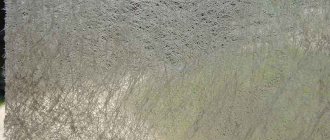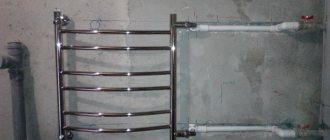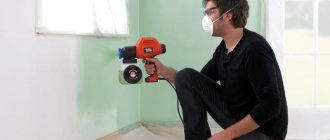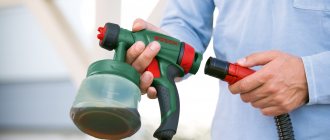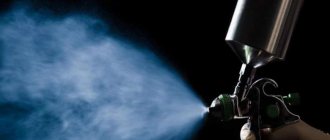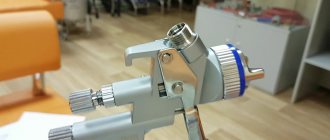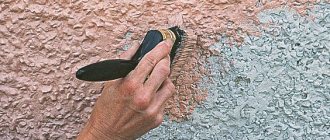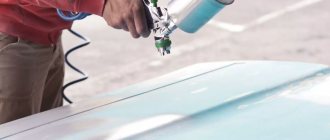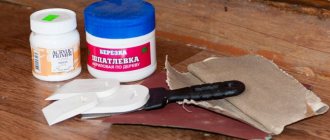It is known that repairs include certain nuances, without which it will not be possible to properly hang wallpaper, attach insulation or paint the walls. This also applies to water-based paint, which must be diluted beforehand. It is necessary to dilute water-based paint so that it is easier and better applied to the coating.
It is advisable to dilute water-based compositions before painting the ceiling, walls or other coating. If it is not diluted, it will cause a number of difficulties during application - an uneven layer, bumps on the base, streaks, and so on. Next, we’ll look at how to dilute water-based paint.
Do I need to dilute water-based paint with water?
| 2 Water-based paints are, in principle, sold ready-to-use. But there are times when it is still necessary to breed them. For example, if you are going to paint in two layers. Then, of course, the first layer must be applied with paint of a more liquid consistency. There are also cases when the paint thickens from long-term storage - then it also needs to be diluted. Water-based paints are diluted with plain water. To dilute the water-based emulsion, you need to pour the paint from the can into a larger container and, while continuously stirring, gradually pour in water. Water should not be more than 10% of the paint volume. the author of the question chose this answer as the best 2 The fact is that manufacturers write for a reason that the amount of water in water-based paint should not exceed 10 percent. But really, let's figure out why exactly 10 percent and not more. In this case, the answer is in the name of the paint itself. And so the paint is called water-based paint. This means that it is a water emulsion. And now I will reveal the professional secrets of the developers of this paint. The fact is that emulsifiers are used to obtain a stable aqueous emulsion. And they differ for different paints. But a change in their concentration in the solution can lead to the formation of an unstable emulsion and, naturally, poor-quality paint. Here is the composition of some water-based paints. And here the manufacturers are cunning and do not indicate emulsifiers or, as they are also called, dispersants, and it is thanks to them that water-based paints were created. 1 If the paint is fresh for up to 6 months (and for this, look at the date of manufacture) and the lid on the can has not been opened since the date of production, then I would not recommend diluting it with anything, since any diluting is an interference with the composition of the paint. If a can of paint has already been opened and stored for a long time, or if the paint is old, then it is best to dilute it. This must be done carefully. Firstly, you should not overuse the solvent, its volume should not exceed 10% of the paint volume, otherwise you will get a very liquid mixture and will have to paint in several layers. Secondly, in order to achieve quality, I would recommend diluting with disciplined water or, as a last resort, drinking from bottles. Thirdly, the temperature of the water and paint should be the same or tend to it. Fourthly, dilute the paint mechanically, using stirrers, and not just move a stick in a circle a couple of times in the jar, and also scrape the paint from the walls, or even better, pour the paint into a clean new container and dilute it there. 1 The manufacturer of water-based paint clearly writes on the container in the instructions whether or not to dilute a particular water-based paint. Sometimes the container contains the inscription “before applying to the surface, dilute with water 5.10% of the total mass.” This type of paint is most often labeled “concentrated”. If there is such an inscription, then we dilute it, if there is no inscription, then we just thoroughly mix the paint and that’s it. Sometimes the user makes his own decision; in principle, you can dilute it if the thickness of the paint does not suit you. And the second dilution option is if water-based paint is applied as the first primer layer, in this case water is also needed, diluted water-based paint in this case acts as a primer. You can or cannot use a specific paint for the primer layer, and this is written on the container. The expiration date and proper storage of paint (tightly closed container) can also influence the decision to dilute. The paint may thicken and can only be revived with water and thorough stirring. 1 Water-based paints purchased in hardware stores are as ready as possible for painting work. In the case, especially when a large container of paint was purchased, which was not completely used immediately, and the paint remained in it, then after some storage you need to add water to the paint. After even a short storage, the paint thickens slightly, which is affected by the loss - evaporation - of water. In this case, it is necessary to add a small amount of water, mix thoroughly, slowly, otherwise tiny air bubbles may form in the paint, which will fall on the surface to be painted and may leave unsightly dots on it. Good luck. 1 Emulsion paints are sold ready for use. New paint can be thinned when painting in 2 layers, but it only needs to be thinned when painting the first layer, which is logical. If the paint has been sitting idle for a long time, then after thorough mixing it can return to its consistency. If this does not happen, dilute with water. It is also possible to dilute it with water if you pour it into a spray bottle. 1 The result of painting depends on the manufacturer of water-based paint. I am writing based on personal experience. If the paint is of high quality, dilution with water, within reasonable limits, does not affect the quality. The paint savings are significant. 0 You can always read about whether it is necessary to dilute water-based paint in the instructions on the paint can; the conditions for painting should also be written there. The paint has already been diluted to the required consistency and thinning is most often not necessary. But you should guide yourself: if it’s thick, then it’s worth diluting. How to dilute water-based paint? Water. Add water little by little and stir the paint thoroughly; it is best to use a drill with a special attachment. There are different attachments, for example this one, in my opinion, is the most convenient: Also remember that the drill should not be turned on at high speeds - you will splatter the paint. It’s hard to say exactly how much water to pour, because it depends on how thick the paint is. Here you need to rely on your personal experience so as not to overdo it. 0 Water-based paint, like regular enamel, is already ready for use, but it happens that it is too thick for a spray bottle or has thickened after long-term storage - in this case, water-based paint can and should be diluted with plain tap water to the required thickness; you need to add water to the paint very in small portions while stirring very well. The amount of water for diluting water-based paint in each specific case is selected experimentally. I would also recommend that if you haven’t used the paint completely, pour just a little water on top without stirring, close tightly and store the paint, so it will thicken less and retain its quality longer. 0 We recently started renovating a room, and for the first time we bought water-based paint. When purchasing, the seller herself recommended diluting the water-based paint with water, since it was thick. We added a little water to reduce the thickness of the paint, and stirred the paint with a stick. So if you want, you can of course add water. Do you know the answer? |
How to dilute
The homogeneity of the mixture ready for application largely depends on the component used in the dilution. Before diluting paint for a spray gun, you should read the manufacturer’s recommendations on the packaging, since each paint and varnish material has its own unique composition. Unfortunately, there is no universal means for thinning paint, and although we know such famous solvents as 646 or white spirit, they are not suitable for all paint and varnish mixtures. For example, acrylic-urethane paint is best diluted with solvent R-12, and if you use the previously mentioned products, you can burn the coloring pigment.
You can use universal solvents only when you do not know the name of the paint and are pouring it from an unnamed canister. Or, if the quality requirements are as low as possible. In other cases, you should follow the recommendations on the packaging of a specific mixture or on the manufacturer’s official website.
HOW TO DILUTE WATER-EMULSION PAINT
Water-based paints can rightfully be called one of the best offers on the market of paints and varnishes. These paints mix very well and easily and allow you to achieve bright and rich colors. And, of course, they have a wide color palette. Plus, you can add to this that water-based paints dry quickly and are resistant to atmospheric influences. They can be used for both external and internal work. But in order to know how and with what to dilute paints of this type, you need to know their composition and characteristics.
COMPOSITION AND CHARACTERISTICS OF WATER-EMULSION PAINTS
To avoid problems with choosing a solvent, you first need to know the composition of the paint. Currently, all types of acrylic paints have three components: color pigment, water and a binder. An acrylic-based polymer emulsion is used as a binder.
As we have already said, the use of these paints is very wide. But to avoid any unpleasant surprises, always follow the manufacturer's recommendations on the can.
Water-based paints are often sold ready-to-use, and many manufacturers do not recommend thinning them. However, sometimes, especially for the primer layer of surface painting, it is still better to dilute the “water-based emulsion”.
WHAT AND HOW TO DILUTE WATER-EMULSION PAINT?
There are two main ways to dilute water-based paints. Let's look at these methods in more detail. Based on the fact that the basis of water-based paint is water, it is logical that it should be diluted with ordinary water, making sure that there are no foreign impurities (chemicals or solid particles) in it.
Tap water is quite suitable for diluting water-based paint; it is advisable to just let it sit for a couple of hours.
If the paint will be applied by spraying, use special thinners for water-based paints. These thinners can be purchased at any hardware store. There are two types of water-based paint thinners: matte and glossy, which are selected depending on the type of surface you want to obtain, matte or glossy.
HOW TO DILUTE DRIED WATER-EMULSION PAINT?
But sometimes it happens that the paint has been in the can for a long time and has had time to dry. And in order to carry out any painting work with this paint, it needs to be diluted to a working condition. We would like to warn you right away that the more the paint has dried, the worse it will be after dilution.
If the acrylic paint has dried too much, i.e. small lumps begin to appear in it, then such paint can be restored using an aqueous-alcohol solution or a special acrylic thinner. If the paint has not dried so much and it still retains its inherent elasticity, then you need to act differently. Use sharp objects to shred the paint and then pour hot water over it. After a couple of minutes, drain the water and repeat the “procedure” again. Then drain the water again and stir the paint.
Of course, the quality of such paint will decrease, but it is suitable for most types of painting work.
How and with what to dilute water-based paint? This question comes up quite often. The right decision is a guarantee of reliable and durable coating and the absence of complications during operation.
Preparation and coloring process
Latex paint is a safe finishing option that is suitable for absolutely any room. In addition, it contains no toxins, such paints dry quickly and do not have a specific odor.
To dilute this type of paint, only purified or drinking water can be used.
There are no fundamental differences when painting ceilings and walls using latex composition.
The most important condition is that it is better to treat ceilings in heated rooms, because at low temperatures the coating will crack
Suitable for use in rooms with high humidity. The processing process involves several stages:
- First, you need to prepare the surface for painting - get rid of the old paintwork, level the base with putty.
- The ceiling or walls must also be treated with a deep-action soil mixture.
- Then the composition must be diluted with clean and cold water.
- The mixture should be left for five to ten minutes, after which the tinting paste should be added to it. It is advisable to dilute with a small margin, since the exact shade is almost impossible to repeat.
- Painting can be done with a spray, rollers or brushes. It all depends on capabilities and personal preferences.
- Each subsequent layer should be applied only after the previous one has dried.
Experts say that it is preferable to use a roller for work. This tool leaves no traces behind and allows you to save paint. You can use a brush to treat hard-to-reach areas. It's hard to say which is better - acrylic or latex paint. It all depends on the goals being pursued.
Latex compositions have gained such wide popularity that today there is even a special design trend - latex-based interior compositions. Interior paints are characterized by the fact that they are based on silicone resins. These mixtures have excellent quality, a wide range of bright shades, high abrasion resistance and high cost.
It should also be noted that latex composition for the floor and for the ceiling are completely different types of paints
If the packaging does not say that the water-based emulsion can be used to paint the floor, you should pay attention to this
Latex and silicone based paint solutions demonstrate the highest level of effectiveness for external and internal work. They dry quickly, are reasonably priced, provide effective surface protection and are odorless.
When is it necessary to dilute water-based compositions?
Water emulsion is a water-based composition. It contains various fillers in the form of small droplets, which give the material its final properties. As the solution is applied to the surface, some of the liquid is absorbed and some evaporates. Due to the rapid removal of moisture, a protective layer is formed after a short period of time. Final drying depends on the surface material.
Diagram showing the process of water evaporation with the subsequent formation of strong bonds when applying water-based paint to the surface
Nowadays there are various versions of water-based (water-dispersed) paint on sale. Many manufacturers produce products under their own brands. Therefore, it is advisable to dilute the mixture, taking into account the individual characteristics of each variety in the following cases:
- If after opening it turns out that the solution is too thick, then it needs to be diluted. Determining that the consistency is not suitable for application is quite simple: to do this, mix the composition well. If a large amount of product remains on the stirring object and does not flow back, then the use of a solvent is necessary.
When diluting the paint, it is important not to overdo it, since the film thickness decreases when the composition is diluted, which means the performance characteristics of the coating are reduced.
- If the tools used make it difficult to apply the thickened composition. The process is carried out manually and mechanically: For the first option, brushes and rollers are used. Manual processing of walls and ceilings requires that the structure of the mixture be more viscous. This ensures the uniformity of the layer and the absence of drips that arise due to the fact that the paint is too liquid.
- The second method is to use a spray bottle. This device greatly simplifies the process and allows you to perform work over large areas. The peculiarity of the tool is that the coloring composition passes through the nozzle under pressure, due to which the suspension lies more evenly on the base. Therefore, to use the spray gun, the consistency must be liquid. Compared to the previous version, the viscosity decreases by 1.5–2 times. The exact proportions depend on the model of the instrument and the type of water-based composition.
Currently, the market offers specialized spray guns for water-based paints, both electric and manual.
- If the conditions of storage and use of products are violated. It happens that the container is not sealed tightly after opening. If the situation is not corrected in time, the material will become completely unusable. But at a certain stage, when the mixture has not yet dried, it can be restored.
On a note! If the composition is liquid, this can be corrected in two ways: let the water evaporate a little or add a hardener. The second method is more complex; it is used in cases where the paint initially does not have the desired consistency.
Preparation of the dye
To give water-based paints the desired shade, you should follow some tips:
- accurately calculate the required amount of tinting agent for a given volume of paint;
- when buying a color, you should be guided by the catalog provided by the manufacturer to see what shade the final result will be;
- if you plan to create a complex tint collection, you need to use special tables that show the final result of mixing paint with different shades;
- when using an unfamiliar pigment, you do not need to mix the entire volume of paintwork at once, you first need to try it in a small container (the dishes should preferably be white);
- if the shade of the already dried paint is not satisfactory, you will have to change the proportion of the dye;
- after a suitable shade has been selected, you can knead the entire bucket;
- it is necessary to mix the pigment with the base material very carefully, because the final result of the painting work depends on this;
- To obtain the optimal consistency, you can stir the substance with a drill with variable speed control and an attachment for mixing plaster;
- set the speed to a minimum so that the paint does not fly in different directions;
- if it still splashes, you should switch the adjustment to “reverse” mode;
- immediately before applying the paint to the surface, mix it thoroughly again.
Using water to thin paint
The correct choice of thinner is the key to success. There are many tips and tricks for using different substances for this process. But the only correct solution is to use water, since it is the basis of the product.
For best dilution, the liquid must meet certain parameters:
- Temperature.
The water should be at room temperature. If work is carried out outside, then a component is added to the façade solution that is slightly higher than the ambient temperature. When deciding how much solvent to add to the paint, it is important to consider that at low temperatures the composition tends to thicken, and in hot weather it tends to become more liquid - Presence of impurities. Water is an excellent solvent, so it may contain a large amount of unnoticeable substances that have a detrimental effect on the coloring solution (reduce its properties, change color). The best dilution occurs with distilled water. You can obtain purified liquid at home in different ways. If the impurities are too active, the diluent is brought to a boil and allowed to settle.
Distilled water can be found in almost any hardware or auto store, less often found in pharmacies
Attention! There is advice that dilution can be done using solvents used for enamel or oil paint. It is not right. If such a substance is added to a water-based emulsion, the mixture often simply curdles. However, the reaction may not appear immediately, which is misleading.
Features of paints
Water-based solutions are artificial mixtures that are used to coat products to protect against corrosion. Products of this kind are especially popular because they are environmentally friendly for humans and the environment.
The water emulsion consists of several main components:
- Dyes. These are special substances that have a homogeneous structure.
- Solvent. This product uses ordinary water, which quickly evaporates without emitting unpleasant and harmful odors.
- Binder mixture. The composition of the paints can be supplemented with various additions that affect the technical characteristics of the solutions.
Water-based paints have several significant advantages over their analogues:
- Low cost. Anyone can buy such compositions; it won’t hurt your wallet.
- Drying speed. Some types of solutions gain strength within a few hours after application.
- Environmentally friendly. The mixtures contain only safe and natural products.
- Good mixing properties. This allows you to change the color of the paint by adding different colors, which should be added to the solution in the required quantity.
Paints of this type are not practical. They can be applied provided that the air temperature is above +5 degrees. Since the mixture contains water, the film layer can be easily wiped off with a liquid. Therefore, such paints are used only in relatively dry rooms, where there is no direct exposure of the painted surface to aqueous solutions.
Water-based paints have been on the market for a long time. The popularity of the material has led to the emergence of several types of these products. Depending on the type of binder, several types of paints can be distinguished:
- Latex. The most popular solutions that can be washed after drying. The advantage of these products is their plasticity, which allows them to seal small cracks.
- Acrylic. The main component of the solution is acrylic resin, which protects materials well from moisture. Such paints are characterized by elasticity and high cost.
- Silicone. Here, silicone resins are used as a connecting element. These varieties are characterized by plasticity.
- Silicate. Paints of this type are not able to repel water well, so it is best to paint surfaces while wearing special protective clothing.
- Polyvinyl acetate. PVA glue is added to the composition of this paint, which qualitatively binds the pigments together. This material is the cheapest and short-lived, so it is used quite rarely.
Proportions
The biggest problems (especially for those who do all the work themselves and without experience) arise from proportions. The fact is that there is no clear correlation; you should be guided by the parameters that each specific manufacturer indicates on the label.
General recommendations look like this:
- Up to 10% liquid can be used for dilution.
In this case, the exact parameters depend on the surface material and paint brand. On the label, the manufacturer always indicates the permissible percentage of thinner to the total volume of paint - Different technologies for performing work imply that breeding will be different. For example, if a water-based acrylic composition is applied in three layers, then for the first application 5–8% water is added to the solution. The resulting mixture is well distributed over the base. This coating is often a primer. For the second layer, 2–3% liquid is used, the third does not require dilution. This allows you to obtain a high-quality and reliable surface.
- Adding water is not always justified. If there is an optimal consistency and viscosity suitable for hand tool use, water will only increase paint consumption.
On a note! Excessive dilution is practiced by unscrupulous craftsmen. This makes it easier to lay each layer, reducing the decorative effect. In addition, if the purchase is not carried out by the owner of the apartment, this makes it possible to increase the estimate.
How to dilute paint?
To dilute the selected material with water, there is no need to use complex equipment. To work you will need a simple set of devices:
- clean container of suitable size;
- drill with mixer attachment;
- small spatula (if you need to remove lumps).
Breeding scheme:
- The paint is poured into the container. The process is carried out carefully, the composition is mixed a little.
- Water is added gradually. Even taking into account the proportions specified by the manufacturer, it is better to constantly check the viscosity.
- After adding each portion, everything is thoroughly mixed. If lumps are visible, it means that uniformity has not yet been achieved.
It should be borne in mind that the volume is affected by color, so it is added diluted in liquid.
How and with what to dilute thick water-based paint?
Combining different finishing materials in the interior of one room is a trick of modern designers. Therefore, water-based paint is no less popular than in the old days, when both walls and ceilings were completely painted with it. This material is durable and non-toxic, it is easy to apply, does not form cracks, and all these positive qualities are supported by an attractive price.
This dye is easy to use, however, before you begin, make sure that the liquid has the right consistency. If it is too thick, then you will have to think about how to thin the water-based paint for your specific needs.
Types of paints
The operating principle of the spray gun allows it to spray absolutely any flowing materials. Today, there are dozens of paint manufacturers on the market with thousands of different mixture options. It is impractical to analyze each product separately, but we will tell you about the 5 main groups from which all possible derivatives come.
Alkyd enamels
. They are created on the basis of varnish mixed with various solvents, fillers and color pigments. Widely used to coat wood, metal and even concrete. White spirit is often used as a thinner for alkyd enamel.
Acrylic paints
. They are based on ester polymers. Most often used in painting. As a material in finishing works, it can be applied to wood, metal and plaster. Dilute with ordinary or distilled water at room temperature.
Water-based paint and its types
So, first you should figure out what water-based paint is? This is a water-based paint and varnish material. Most often it is used for interior decoration - painting walls and ceilings, but some of its varieties are also suitable for exterior work.
Water-based paints come in several types:
- polyvinyl acetate: their base is PVA glue, and the main advantage is an affordable price;
- silicate: they are a solution of liquid glass and do not have good moisture resistance;
- silicone: designed for outdoor use, made on a resin basis and have high strength and durability;
- acrylic: wear-resistant and expensive, the basis for their production is also resin;
- latex: do not fade and are not afraid of water, so they can be washed without fear.
All these types of paints and varnishes can be diluted with water if necessary, and this is a certain convenience.
Classification of water-based dye by composition
Water-based paint is divided into 4 types based on the polymer, which is considered the basis of the dye:
- Composition: acrylic . Components: acrylic resins, various additives that form the technological qualities of CM. For example, the addition of lactose increases the tolerance of high humidity to the painted surface. Acrylic dye is applied to concrete, metal, wood, plastic and glass surfaces. KM dries quickly and there is no unpleasant smell in the room.
- Silicone composition. Widely used despite the high price. Can be applied to a damp surface, the coating is vapor permeable. Irregularities on the wall up to 2 mm can be easily eliminated.
- Water-emulsion silicate CM. This is a tandem of water emulsion and liquid glass. The coating reduces excess humidity in the room by absorbing it. When the humidity level drops, it releases it back. Paint is often applied to external surfaces because it can withstand weather conditions.
- Mineral composition of water emulsion. The constituent elements are cement or slaked lime. Concrete, brick and plaster are coated with the composition. CM is distinguished by its tolerance to sunlight, humidity, and chemical exposure.
How and when should paint be thinned?
Typically, it is not necessary to dilute water-based paint from a freshly opened can that has not expired, since its consistency is usually suitable for application to the surface. This need may arise if you decide to use a paint sprayer or if you use thickened residue from an old can from a previous renovation. In this case, you cannot do without dilution, because if the container is open, the paint and varnish material in it dries out and thickens over time.
In order to return the paint material to the desired consistency, let's figure out how to do it correctly.
When breeding, it is enough to follow the following rules:
- the amount of water added should be no more than 1/10 of the volume of thickened paint;
- the finishing material should be diluted gradually, achieving the required thickness using a construction mixer or a drill with a mixing attachment;
- Having received the desired consistency, you should not immediately start applying the material to the surface - the foam formed after whipping should completely settle to the bottom;
- You can check whether the paint is diluted correctly by dipping a brush into it and running it over the surface - if the resulting solution is applied evenly, no strokes are visible, it does not flow or roll off, then everything was done correctly.
Preparing the Paint
When opening a container of paint, its consistency is almost always much thicker than required for the job. Therefore, the paint is thoroughly mixed, adding water in small portions so as not to dilute more than necessary.
This operation is most conveniently performed with a screwdriver with a mixer attachment. If you don’t have a power tool, you can stir with any object, but it takes a long time and the quality is a little worse.
The easiest and fastest way to stir paint is to use a screwdriver with a mixing attachment.
If the wall design is creative and involves the surface shimmering under streams of light, it is at this moment that various sparkles are added to the paint. But such ideas come to owners quite rarely.
If small grains appear on the surface of the paint in the funnel, the water-based emulsion must be filtered through 3 layers of gauze.
Paint tinting
Giving paint a certain color and tone at home is carried out according to the following algorithm:
- The water emulsion is poured into a large container (usually a 10 liter bucket) so that it is enough to paint the walls in one room, since it is almost impossible to obtain the same color and shade again. As an exception, for a wall with a window you can make the paint a little lighter, as a result of which the room will visually appear larger;
- adding water in small portions, the paint is brought to the required consistency while mixing;
- Tinting pigments are added to the water-based composition, after which the paint is thoroughly mixed. If necessary, the resulting color is adjusted: new pigments are added or the number of those already added is increased. Everything gets mixed up again;
To see the final result you need to paint a small section of the wall.
- With the resulting paint, a small section of the wall is painted so that after about 2 hours you can see the real color scheme of the interior. If the result is not satisfactory, the tinting process continues.
Tips and tricks
- The volume of paint and varnish material is always indicated on the packaging, but if you need to dilute the remains, then it is risky to determine its quantity by eye. To accurately calculate how much paint is left, just pour it into another container using a measuring cup or a liter jar.
- The temperature of the water used for dilution should be between 18–30 degrees. It is not recommended to use ice or hot water for dilution, as this will negatively affect the uniformity of the material.
- It is better to use purified bottled water as a diluent. Besides, you don’t need much of it, so you can be a little generous. Impurities present in process water may not have the best effect on the characteristics of water-based paint.
By following these simple rules, you can save a lot on the purchase of new materials and at the same time free the pantry from stale remnants of material.
Recommendations
Mixing water-based paint is a fairly simple operation that can be performed even by an untrained person. To get a high-quality mixture, you should follow a few simple recommendations.
Observe proportions when mixing. It is advisable that the volume of added water does not exceed 10% of the total amount. 1 part should be occupied by the solvent, and 9 by the water-based paint itself.
The exact percentages are often indicated on the packaging. Do not exceed the manufacturer's recommendations; this may lead to the film losing its strength characteristics after hardening.
The water should not be dirty. Not every tap liquid can be used as a solution. Various chemical compounds can also affect the quality of dilution. Therefore, it is important to consider the manufacturer's recommendations.
The paint should be dissolved with water at room temperature. Do not use hot liquid as it may break the bonds between the dye and the base mixture. This will result in loss of durability and performance degradation.
If you don't have time, you can mix cold and hot liquid, bringing it to room temperature.
Diluting water-based paint is the ability to obtain a solution of the desired consistency. This approach will allow you to obtain not only a reliably protected, but also a beautiful surface, which is practical and has a long service life.
For information on what water-based paint is, see the following video.
It is known that repairs include certain nuances, without which it will not be possible to properly hang wallpaper, attach insulation or paint the walls. This also applies to water-based paint, which must be diluted beforehand. It is necessary to dilute water-based paint so that it is easier and better applied to the coating.
It is advisable to dilute water-based compositions before painting the ceiling, walls or other coating. If it is not diluted, it will cause a number of difficulties during application - an uneven layer, bumps on the base, streaks, and so on. Next, we’ll look at how to dilute water-based paint.
How to tint paint?
Sometimes the paint is also diluted with color. If you plan to make the room bright, but you only have white paint, purchased earlier for painting the ceiling, then you should not spend money on a new can - just buy the necessary color pigment.
To achieve the desired color you will need:
- a jar of color scheme of the desired color;
- large clean capacity;
- mixer;
- water at room temperature.
The existing white water-based paint is poured into a thoroughly washed and dry bucket. Then pigment is gradually added to it, after which the solution is kneaded with a mixer.
In no case is it necessary to pour the entire jar of color into the finishing material at once, since despite the fact that there is not much of it there, the color can turn out very bright. As a result, it will become clear whether the mixture needs to be diluted additionally with water. This is necessary in several cases: if the paint is too thick, it flows heavily from the brush and clumps when applied to the surface and if you need a certain consistency for the spray gun.
In order not to overdo it with the pigment and to get as close as possible to the desired shade, it is better to first mix a small amount of white water-based emulsion with the color in a separate bowl, and only then add color to the rest of the paint.
Dilution technology
Water-based paints interact well with water. Therefore, diluting such a composition is quite easy and quick. This process consists of several sequential steps:
- Initially, you should take the required amount of paint into one container, and pour clean water into the second.
- Then liquid is added to the mixture in small portions. It is important to constantly stir the solution, this promotes uniform distribution of all components.
- If you need to change the color, you can add a special color along with water. The shade is selected individually, it depends on the characteristics of the original solution. In a similar way, decorative sparkles can be introduced into the structure.
Read also: For what purposes are Russian Railways torque wrenches used?
When mixing water and water-based emulsion, foam may form on the surface of the solution. It is advisable to use the liquid after it has settled and the mixture has become homogeneous.
Adding a decorative element
Color is also not the last thing that can be added to a white water emulsion. You can give the room a fabulous atmosphere by mixing a decorative element into water-based paint. This additive can be purchased both on the market and in a construction supermarket. It can be sparkles or a mother-of-pearl effect.
When it is planned to make the surface bright and rich, decorative paint is applied over water-based paint. At the same time, do not forget that each subsequent layer can be painted on top of the previous one, after an hour - the interval must be observed so that the material has time to set.
For lovers of more muted and calm tones, a logical question arises: is it possible to make the room unusual, but not make the walls too bright? Yes, this can be done by simply adding a decorative element to the paint and color scheme. The mixing procedure is no different from the previous one: glitter is added to the pre-tinted mixture, and then it is all thoroughly mixed with a mixer and, if necessary, diluted with water.
Paint removal methods
There are several options for removing water-based paint. Which one is right for you depends on where, to what extent and for how long the unwanted stains are located, as well as the availability of suitable materials.
When choosing a method, it is important to consider that some of them can damage the stained surface. To prevent this from happening, follow our instructions exactly.
Removing paint from the surface using a spatula
This option is suitable for removing old water-based paint from the ceiling or walls before applying a new coating or when using other finishing materials, for example, when using wallpaper in the future.
Attention! This method is not suitable for removing paint stains from parquet, linoleum, lacquered furniture or painted plank floors, as it may ruin its appearance.
Materials you will need: water at room temperature, a clean and absorbent roller or large sponge, spatula, oilcloth or newspaper to protect the surface, safety glasses.
Paint removal process:
- If you are cleaning a wall or ceiling, remove all furniture from the room and cover the floor with plastic sheeting or newspaper.
- Wet the surface to be treated generously with water using a roller or sponge.
- Leave the water-based paint stains to soak for 20 minutes.
- Remove the paint with a spatula.
Removing old stains
If you need to scrub away stubborn stains, you can use a steel wool pad, however, this method is not suitable for all surfaces.
Here is an example of how to remove old water-based paint from delicate materials:
Materials for removing water-based paint: hot water, washing powder, dishwashing sponge, dry rag.
How to remove old stains:
- Dissolve a small amount of powder in water.
- Wet the stained areas with a large amount of solution (you must literally squeeze a sponge soaked in soapy water onto the stain).
- Leave the paint to soak for 30-40 minutes.
- Remove the stain with the rough side of the sponge.
- Wash the cleaned surface with water.
- Blot off excess moisture with a rag.
Attention! If you have stained a parquet floor coated with a special oil, do not soak the stains on it for more than 2-3 minutes because the oil does not protect the wood from prolonged exposure to moisture.
In this case, clean the floor in several approaches, between which wipe the damp areas dry.
Removing paint using solvents
When the paint has become so deeply embedded that none of the methods described above helps, solvents come to the rescue.
There are special preparations for washing off water-based paint; they can be purchased at hardware stores and construction markets. Instructions for their use are often written on the packaging.
If buying expensive drugs is not part of your plans, you can use regular acetone or nail polish remover, or formic acid.
Materials needed for this method: acetone, dish sponge, large piece of cotton wool, rubber gloves, respiratory protective mask, rag, water, soap solution.
Process for removing stains with acetone:
- Clean the stain with as much soap and water as possible.
- Rinse the area to be treated with clean water and wipe it dry.
- Soak some cotton wool in acetone and rub the remaining stain thoroughly.
- Rinse off the acetone with clean water.
- Ventilate the room.
Attention! The fumes from some solvents are very toxic, so be sure to wear protective gloves and a mask when working with them.
Removing paint using a sander
When you stain your parquet floor with water-based paint and cannot wipe it off using any of the previously described methods, you will have to remove the top layer of parquet using a sanding machine.
For this method you will need: a grinding machine, water, soap solution, a rag, a sponge, a mask to protect the respiratory tract, a broom, a rubber spatula.
The procedure for removing stubborn water-based paint using a grinding machine:
- Remove all furniture from the room.
- Clean off the whitewash as much as possible using a spatula and soap solution.
- Sweep and dry the floor.
- Plug in the sander and run it evenly across the floor.
- Sweep up any resulting wood dust.
- If traces of paint remain, repeat the procedure again.
- Wash the floor with clean water.
- Ventilate the room.
How to Remove Dye from Clothes
When working with water-based paint, you must use special work clothing, which can be cleaned of paint if necessary.
Some tips on how to do this.
- Immediately, as soon as the paint gets on the fabric, wipe the stain with a napkin or paper.
- You can wash soiled clothes in hot water with washing powder.
- If the stain is not washed off, then pour a little dishwashing detergent on it and leave it like that for 30-60 minutes.
- Wipe off any remaining stain.
- Rinse clothes in plenty of cool water.
Mixing proportions
As you can see, pigmenting additives have different purposes and are presented in the form of colorants or pastes. The composition of the color does not contain binders; instead, dispersing resins are used to increase solubility and reduce the viscosity of the paste. Base paints are mixed with pigment substances in the following proportions:
- for water-based ones - no more than 20%;
- for oil - 1.5 or 2%;
- for other compositions no more than 5%.
This amount is enough to optimally impart saturation without harm to the treated coating. There are two types of pigments: organic and inorganic.
The first option has a rich and bright shade. But the prepared compositions on such a basis are characterized by insignificant light resistance and a low level of resistance to alkalis, which are released from mineral plaster. These include: soot, manganese, ocher, as well as umber and lapis lazuli.
The second option has high light resistance, but the choice of color collections is limited - these are lutein, rhodopsin and carotene.
If tinting pastes and other pigments have a high percentage of saturation, then this will limit their addition and mixing with water-based paint. Do not forget that a high concentration of pigmenting substance reduces the properties of the coloring material itself.
The color of the water-based paint is combined with the paintwork material itself immediately before application to the required surface, so that the pigment does not settle to the bottom. The finished product is used both inside and outside the building. Concrete, wood, brick, and putty surfaces can be painted.
Some useful tips
- If you stain your long hair with water-based paint, immediately wash it several times with water and shampoo. Once your hair is dirty, you will no longer be able to clean it.
- Apply the water and soap solution to the walls and ceiling in small areas so that the surface does not have time to dry while you are removing the paint at the other end of the room.
- Remember that fresh stains that have not yet dried out are easier to remove.
- DIY chimney cleaning
- Do-it-yourself home mini sauna in an apartment
- How to dry the basement and cellar from dampness
- How to remove mold from an apartment
Discuss the article on the forum We recommend
Popular posts
- Chair for dressing table Chairs for dressing tables in Moscow - 189 Products Company from Moscow, delivery 29643 a In…
- Silicone sanitary sealant Silicone sanitary sealant white in Moscow - 1491 products Company from Moscow, delivery (tomorrow) 140...
- Shelf in the hallway Currently, there are a huge number of different options for shelves in the hallway, and this is directly ...
- Insulation of the floor in a wooden Insulation of the floor in a wooden house from below: materials and installation technology SHARE ON SOCIAL NETWORKS One of the common…
